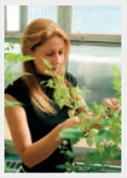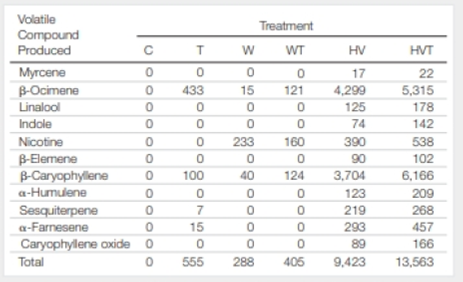

Volatile Secondary Metabolites in Plant Stress Responses In 2007, researchers Casey Delphia, Mark Mescher, and Consuelo De Moraes (pictured at left) published a study on the production of different volatile chemicals by tobacco plants in response to predation by two types of insects: western flower thrips and tobacco budworms. Their results are shown in FIGURE 30.19.

FIGURE 30.19 Volatile (airborne) compounds produced by tobacco plants in response to predation by different insects. Plants were untreated (C), attacked thrips (T), mechanically wounded (W), mechanically wounded and attacked by thrips (WT), attacked by budworms (HIV), or attacked by budworms and thrips (HVT). Values are in nanograms/day.
Which treatment elicited the greatest production of volatiles?
To find: The treatment that elicited the greatest production of volatiles in tobacco.
Concept introduction: One of the most striking features of plants is that they are capable of producing sugars by using the sun light; this phenomenon is called as photosynthesis. Thus, the sugars that are produced are primary metabolites. In addition to this, the plants also produce secondary metabolites. Secondary metabolites are mainly involved in the plant interactions with the environment where they live and help to adjust the behavior and growth of the plant. Volatile compounds produced by the plants are mainly the secondary metabolites. They are the compounds that provide smell and taste to the plants.
Explanation of Solution
Plants attacked by budworms and thrips (HVT) or budworms alone (HV) produced a total of 11 different volatiles in the amounts of 13,563 ng/day and 9,423 ng/day, respectively. The greatest production of volatile compounds produced in tobacco plant is mainly due to the treatment of HVT. It has produced 13,556 ng/day, which indicates that the treatment has a very large impact on the secondary metabolite production in tobacco.
Plants that are attacked by budworms and thrips (HVT) have produced the maximum volatile compounds in the amount of 13,563 ng/day. There are 11 compounds produced by tobacco by this treatment.
Want to see more full solutions like this?
Chapter 30 Solutions
Biology: The Unity and Diversity of Life (MindTap Course List)
Additional Science Textbook Solutions
Genetics: From Genes to Genomes
Fundamentals Of Thermodynamics
Microbiology Fundamentals: A Clinical Approach
Human Physiology: An Integrated Approach (8th Edition)
- What did the Cre-lox system used in the Kikuchi et al. 2010 heart regeneration experiment allow researchers to investigate? What was the purpose of the cmlc2 promoter? What is CreER and why was it used in this experiment? If constitutively active Cre was driven by the cmlc2 promoter, rather than an inducible CreER system, what color would you expect new cardiomyocytes in the regenerated area to be no matter what? Why?arrow_forwardWhat kind of organ size regulation is occurring when you graft multiple organs into a mouse and the graft weight stays the same?arrow_forwardWhat is the concept "calories consumed must equal calories burned" in regrads to nutrition?arrow_forward
- You intend to insert patched dominant negative DNA into the left half of the neural tube of a chick. 1) Which side of the neural tube would you put the positive electrode to ensure that the DNA ends up on the left side? 2) What would be the internal (within the embryo) control for this experiment? 3) How can you be sure that the electroporation method itself is not impacting the embryo? 4) What would you do to ensure that the electroporation is working? How can you tell?arrow_forwardDescribe a method to document the diffusion path and gradient of Sonic Hedgehog through the chicken embryo. If modifying the protein, what is one thing you have to consider in regards to maintaining the protein’s function?arrow_forwardThe following table is from Kumar et. al. Highly Selective Dopamine D3 Receptor (DR) Antagonists and Partial Agonists Based on Eticlopride and the D3R Crystal Structure: New Leads for Opioid Dependence Treatment. J. Med Chem 2016.arrow_forward
- The following figure is from Caterina et al. The capsaicin receptor: a heat activated ion channel in the pain pathway. Nature, 1997. Black boxes indicate capsaicin, white circles indicate resinferatoxin. You are a chef in a fancy new science-themed restaurant. You have a recipe that calls for 1 teaspoon of resinferatoxin, but you feel uncomfortable serving foods with "toxins" in them. How much capsaicin could you substitute instead?arrow_forwardWhat protein is necessary for packaging acetylcholine into synaptic vesicles?arrow_forward1. Match each vocabulary term to its best descriptor A. affinity B. efficacy C. inert D. mimic E. how drugs move through body F. how drugs bind Kd Bmax Agonist Antagonist Pharmacokinetics Pharmacodynamicsarrow_forward
 Human Heredity: Principles and Issues (MindTap Co...BiologyISBN:9781305251052Author:Michael CummingsPublisher:Cengage Learning
Human Heredity: Principles and Issues (MindTap Co...BiologyISBN:9781305251052Author:Michael CummingsPublisher:Cengage Learning Biology: The Unity and Diversity of Life (MindTap...BiologyISBN:9781305073951Author:Cecie Starr, Ralph Taggart, Christine Evers, Lisa StarrPublisher:Cengage Learning
Biology: The Unity and Diversity of Life (MindTap...BiologyISBN:9781305073951Author:Cecie Starr, Ralph Taggart, Christine Evers, Lisa StarrPublisher:Cengage Learning Biology (MindTap Course List)BiologyISBN:9781337392938Author:Eldra Solomon, Charles Martin, Diana W. Martin, Linda R. BergPublisher:Cengage Learning
Biology (MindTap Course List)BiologyISBN:9781337392938Author:Eldra Solomon, Charles Martin, Diana W. Martin, Linda R. BergPublisher:Cengage Learning Biology: The Dynamic Science (MindTap Course List)BiologyISBN:9781305389892Author:Peter J. Russell, Paul E. Hertz, Beverly McMillanPublisher:Cengage Learning
Biology: The Dynamic Science (MindTap Course List)BiologyISBN:9781305389892Author:Peter J. Russell, Paul E. Hertz, Beverly McMillanPublisher:Cengage Learning





